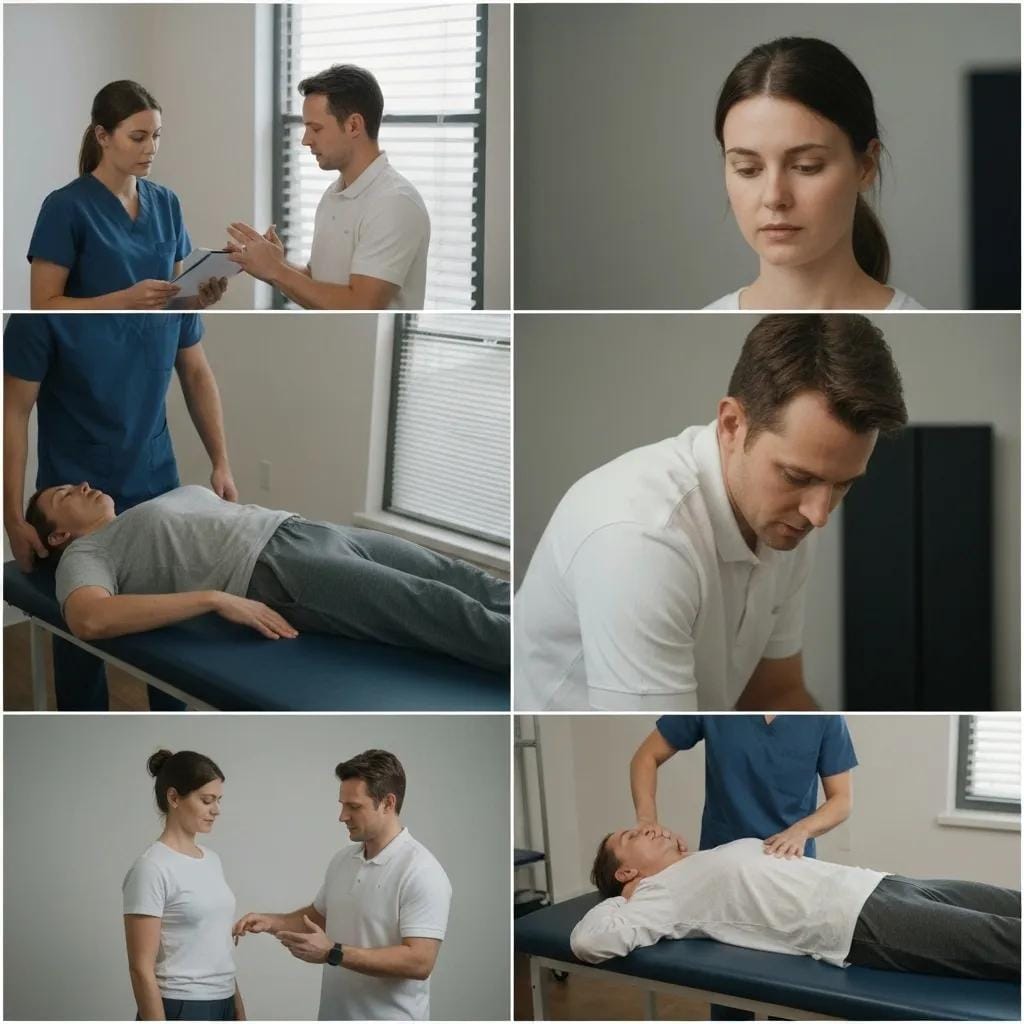
Manual Therapy Techniques: Unlocking Essential Benefits for Pain Relief, Mobility, and Wellness
Persistent aches and stiffness can undermine daily activities and athletic goals, but skilled hands-on interventions offer targeted relief and functional gains. Manual therapy techniques employ precise, therapist-driven manipulations of muscles, joints, and fascia to alleviate pain, restore range of motion, and accelerate healing. In this article, you’ll discover what manual therapy is, explore its core benefits and most common methods, learn how it addresses specific conditions, understand personalized treatment planning, and find out how to schedule your first appointment at rhw-indy.com.
What Is Manual Therapy? Understanding Hands-On Physical Therapy Techniques
Manual therapy is a specialized form of treatment in which trained therapists use their hands to assess joint mechanics, mobilize soft tissues, and correct biomechanical dysfunction. By applying targeted pressure, stretching, and gentle joint glides, manual therapy reduces muscle tension, improves circulation, and restores optimal movement patterns. For example, applying sustained pressure to a tight thoracic muscle can unlock motion in the spine, setting the stage for pain-free everyday movement and more effective rehabilitation exercises.
Closing that tension barrier in soft tissues paves the way for discussing how manual therapy differs from broader physical therapy approaches.
How Does Manual Therapy Differ from Traditional Physical Therapy?
Manual therapy focuses on hands-on techniques to address musculoskeletal dysfunction, whereas traditional physical therapy often emphasizes exercise-based rehabilitation, modalities like ultrasound, and programmed stretching routines.
| Method | Manual Therapy | Traditional Physical Therapy |
|---|---|---|
| Primary Approach | Hands-on mobilization, manipulation | Exercise prescription, modalities |
| Target Focus | Joint mechanics, soft tissue extensibility | Strength, endurance, balance |
| Session Structure | Therapist-driven manual techniques | Patient-driven exercises |
This comparison highlights that manual therapy targets underlying tissue restrictions directly, which naturally leads into its guiding principles and healing philosophy.
Efficacy of Manual Therapy versus Conventional Physical Therapy in Chronic Low Back Pain Due to Lumbar Spondylosis. A Pilot Study
A pilot study comparing Maitland mobilization, a manual therapy technique, with conventional physical therapy (traction and stretching exercises) for chronic low back pain found that manual therapy interventions were more effective in managing low back pain, improving function, and enhancing the range of motion of the lumbar spine.
This research directly supports the article’s distinction between manual therapy and traditional physical therapy, highlighting manual therapy’s direct impact on joint mechanics and soft tissue extensibility for specific conditions.
What Are the Core Principles and Philosophy Behind Manual Therapy?

Manual therapy rests on four core principles:
- Holistic Assessment – Evaluating posture, joint alignment, and soft tissue integrity.
- Root-Cause Resolution – Addressing mechanical dysfunction rather than merely masking symptoms.
- Patient-Centered Care – Customizing technique selection to individual anatomy and goals.
- Integrative Rehabilitation – Combining manual techniques with therapeutic exercises for lasting outcomes.
Embracing these principles ensures that each session lays a foundation for sustainable pain relief and functional improvement.
Which Body Systems and Conditions Does Manual Therapy Target?
Manual therapy primarily targets the musculoskeletal system, including muscles, joints, ligaments, and fascia. It effectively treats:
- Chronic back and neck pain
- Joint stiffness after injury or surgery
- Muscle spasms and trigger points
- Sports-related sprains and strains
- Headaches linked to cervical dysfunction
By focusing on these structures, manual therapy delivers relief across a wide spectrum of musculoskeletal conditions and helps maintain long-term wellness.
What Are the Key Benefits of Manual Therapy Techniques?
Manual therapy delivers four primary benefits:
- Targeted Pain Relief through reduced muscular tension and joint fixation.
- Restored Mobility by improving joint range of motion and tissue extensibility.
- Accelerated Healing via enhanced circulation and scar-tissue remodeling.
- Optimized Function for both athletic performance and daily activities.
These advantages translate into faster recovery, fewer re-injuries, and greater confidence in movement.
Role of Manual Therapies in Musculoskeletal Disorders
Manual therapy (MT) is a hands-on approach used to assess and treat musculoskeletal disorders by applying passive, skilled movement to target anatomical structures. Systematic reviews indicate that MT improves pain and function, and when combined with guided exercises, it tends to be superior to either alone for conditions like back pain, neck pain, and headaches.
This research directly supports the article’s claims about manual therapy providing targeted pain relief and optimized function, especially when integrated with rehabilitation exercises.
How Does Manual Therapy Provide Targeted Pain Relief and Management?
Manual therapy reduces pain by releasing tight muscles, decreasing joint compression, and modulating nervous system sensitivity. Commonly relieved conditions include: our specialties.
- Herniated or bulging discs causing sciatic discomfort
- Cervical stiffness leading to tension headaches
- Rotator cuff or shoulder impingement syndromes
- Iliotibial band syndrome in runners
- Myofascial trigger points in the upper back
Improving tissue elasticity and joint alignment creates a pain-free baseline for therapeutic exercise.
In What Ways Does Manual Therapy Restore Mobility and Enhance Flexibility?
Manual interventions restore mobility by loosening adhesions, stretching contracted fascia, and guiding joints through their full range. Key improvements often include:
- Increased spinal flexion and extension
- Enhanced hip rotation for safer squatting
- Greater ankle dorsiflexion to reduce fall risk
- Improved shoulder abduction to ease overhead reaching
These gains empower patients to move with confidence and reduce compensatory movement patterns.
How Does Manual Therapy Accelerate Healing and Prevent Injuries?
By promoting local blood flow and breaking down restrictive scar tissue, manual therapy accelerates tissue repair and resilience. Improved biomechanics also reduce abnormal joint loading, preventing repetitive-strain injuries. Over time, balanced muscle length-tension relationships lower the risk of future sprains, strains, and overuse syndromes.
How Can Manual Therapy Improve Athletic Performance and Daily Function?
Manual therapy optimizes movement patterns and neuromuscular coordination, supporting:
- Enhanced sprint speed through improved hip mobility
- More efficient weightlifting technique with balanced shoulder mechanics
- Reduced muscle fatigue by addressing trigger points
- Smoother gait mechanics for daily walking and stair climbing
When paired with specific strength and conditioning programs, manual therapy creates a performance edge and elevates everyday functional capacity.
What Are the Most Common Manual Therapy Techniques and Their Benefits?

Practitioners often employ a core set of manual techniques tailored to patient needs. The following table summarizes the main methods:
| Technique | Mechanism | Primary Outcome |
|---|---|---|
| Soft Tissue Mobilization | Pressure and stretch to muscles/fascia | Reduced tension, improved circulation |
| Joint Mobilization | Controlled oscillatory joint glides | Increased range of motion, decreased stiffness |
| Muscle Energy Techniques | Patient-initiated isometric contractions | Enhanced flexibility, neuromuscular reset |
| Strain-Counterstrain | Gentle positioning to release tender points | Relief of acute muscle hypertonicity |
These techniques serve as the building blocks for condition-specific treatment plans and guide the selection of hands-on interventions.
What Is Soft Tissue Mobilization and How Does It Relieve Muscle Tension?
Soft tissue mobilization uses direct pressure, kneading, and fascial stretch to break up adhesions and restore fluid dynamics within muscles and connective tissue. This technique alleviates trigger-point pain, reduces swelling, and encourages effective tissue remodeling.
How Does Joint Mobilization Restore Joint Function and Reduce Stiffness?
Joint mobilization applies gentle, graded glides and traction to arthritic or fixed joints, restoring normal synovial movement and reducing nociceptive input. Patients often experience immediate increases in range of motion and a sense of joint “unlocking.”
What Are Muscle Energy Techniques and Their Role in Enhancing Flexibility?
Muscle energy techniques invite the patient to perform targeted isometric contractions against therapist resistance, followed by passive stretching. This neuromuscular approach resets muscle length and improves flexibility more effectively than passive stretching alone.
The efficacy of muscle energy techniques in symptomatic and asymptomatic subjects: a systematic review
A systematic review of 26 studies concluded that Muscle Energy Techniques (METs) are an effective treatment for reducing chronic and acute pain in the lower back and chronic neck pain. METs can also be applied to increase the range of motion of a joint when a functional limitation is present.
This citation directly verifies the effectiveness of Muscle Energy Techniques, one of the common manual therapy methods discussed in the article, for improving flexibility and reducing pain.
Which Other Specialized Manual Therapy Techniques Are Used?
Beyond core methods, therapists may use: adult speech therapy
- Strain-Counterstrain to release acute soft-tissue hypertonicity.
- Neural Mobilization to glide nerves through restricted pathways.
- Positional Release Therapy for pain modulation via reflex relaxation.
Each specialized approach addresses distinct tissue types and patient presentations.
How Does Manual Therapy Address Specific Conditions and Patient Needs?
Manual therapy adapts to individual goals and diagnoses by combining appropriate techniques, exercise prescription, and patient education. Therapists evaluate each person’s functional limitations and tailor sessions to optimize healing trajectories.
How Is Manual Therapy Used for Sports Injuries and Athletic Recovery?
For sprains, strains, and overuse injuries, manual therapy:
- Reduces acute swelling through gentle lymphatic techniques.
- Restores scar tissue pliability with soft tissue mobilization.
- Corrects faulty movement patterns via joint mobilization.
- Integrates sports-specific drills once mobility is regained.
This phased approach minimizes downtime and supports peak performance.
What Are the Benefits of Manual Therapy for Back and Neck Pain?
By addressing vertebral joint restrictions and associated muscular tension, manual therapy:
- Improves spinal segment mobility to relieve disc-related irritation.
- Normalizes cervical muscle tone to reduce cervicogenic headaches.
- Enhances postural alignment for sustained ergonomic benefits.
- Supports core muscle engagement to prevent recurrence.
Patients often report immediate relief and long-term stability.
How Does Manual Therapy Support Pediatric Patients and Child Rehabilitation?
Gentle manual techniques help children with developmental delays, torticollis, or joint immobility by: pediatric physical therapy
- Providing a non-threatening, hands-on assessment.
- Encouraging neuromuscular integration through playful positioning.
- Reducing muscle tightness without aggressive force.
- Building foundational movement patterns for growing bodies.
Early intervention can accelerate developmental milestones and ease caregiver concerns.
How Can Manual Therapy Improve Mobility and Flexibility for All Ages?
Whether in youth athletics or senior wellness programs, manual therapy enhances everyday mobility by:
- Reducing joint stiffness in osteoarthritic knees.
- Alleviating postural kyphosis through thoracic mobilization.
- Supporting safe flexibility gains in aging connective tissues.
- Empowering patients to maintain independence across the lifespan.
Customized care ensures age-appropriate intensity and progression.
Is Manual Therapy Right for You? What to Expect from Personalized Treatment Plans
Manual therapy is suitable for anyone experiencing pain, stiffness, or functional limitations—ranging from athletes to pediatric and geriatric populations. A personalized plan begins with comprehensive assessment and evolves through ongoing feedback and goal refinement.
What Happens During Your First Manual Therapy Session?
During the initial visit, the therapist conducts a detailed history and biomechanical evaluation, identifies areas of restriction, and explains chosen manual techniques. A gentle trial treatment typically follows, so you immediately sense the effect of hands-on intervention.
How Are Manual Therapy Plans Tailored to Individual Conditions and Goals?
Therapists select specific techniques, set treatment frequency, and integrate corrective exercises based on diagnostic findings and patient objectives. Progress is monitored through periodic reassessments, ensuring that care adapts to changing needs and milestones.
Why Choose Expert Hands-On Care at Our Clinic?
Our therapists combine advanced training in joint mobilization, myofascial release, and pediatric manual therapy with a holistic healing philosophy. This expertise, coupled with a compassionate approach, ensures each patient receives safe, effective, and empowering hands-on care.
How Can You Schedule a Manual Therapy Appointment and Begin Your Healing Journey?
Booking a session with our clinic is straightforward and welcoming for all ages and conditions. From your first phone call to the treatment table, our process is designed to put you at ease and get you moving sooner.
What Are the Steps to Book Your First Manual Therapy Session?
- Contact our front desk to confirm insurance details and availability.
- Complete a brief pre-visit questionnaire to outline your history and goals.
- Schedule an appointment time that fits your routine.
- Arrive a few minutes early for initial paperwork and comfort orientation.
This simple sequence gets you on the path to relief without delay.
How Can You Prepare for Your Manual Therapy Treatment?
Wear comfortable, loose clothing and bring any relevant medical records or imaging. Arrive hydrated and ready to engage in light movement, so the therapist can accurately assess your baseline mobility and comfort.
What Are Common Questions About Manual Therapy Techniques?
Even seasoned patients often ask how manual therapy works and who benefits most. Below are concise answers to the most frequent inquiries on physical therapy.
What Are the Primary Benefits of Manual Therapy?
Manual therapy delivers four key advantages: significant pain relief through reduced muscle tension, improved joint mobility and flexibility, accelerated tissue healing via enhanced circulation, and optimized athletic and daily functional performance.
What Types of Conditions Can Manual Therapy Treat?
Hands-on therapy effectively addresses musculoskeletal issues such as chronic back or neck pain, sports injuries (sprains, strains), joint stiffness, arthritis discomfort, headaches linked to cervical dysfunction, and soft-tissue adhesions.
How Does Manual Therapy Work to Relieve Pain and Improve Function?
By applying targeted mobilizations and soft tissue techniques, manual therapy reduces compressive forces on joints, releases fascial restrictions, and modulates nervous system sensitivity—restoring normal movement patterns and lowering pain signals.
What Is the Difference Between Manual Therapy and Physical Therapy?
Manual therapy is a hands-on subset of physical therapy focusing on joint and soft tissue mobilization, while physical therapy more broadly includes exercise programs, movement retraining, and modality-based interventions such as electrical stimulation and therapeutic ultrasound.
Reclaiming pain-free movement and enhanced function begins with skilled manual therapy. Our hands-on approach at rhw-indy.com integrates personalized assessment, advanced techniques, and compassionate care so you can move, perform, and thrive. Schedule your first session today and experience the essential benefits of expert manual intervention.
Frequently Asked Questions
What qualifications should a manual therapist have?
A qualified manual therapist typically holds a degree in physical therapy or a related field, along with specialized training in manual therapy techniques. Many therapists also pursue certifications from recognized organizations, ensuring they are up-to-date with the latest practices and evidence-based approaches. It’s essential to verify their credentials and experience, especially if you have specific conditions or needs that require specialized care.
How many sessions of manual therapy are usually needed?
The number of manual therapy sessions required varies based on individual conditions, treatment goals, and response to therapy. Some patients may experience significant relief after just a few sessions, while others with chronic issues might need ongoing treatment over several weeks or months. A personalized treatment plan will be developed during your initial assessment, allowing for adjustments based on your progress and feedback.
Can manual therapy be combined with other treatments?
Yes, manual therapy can be effectively combined with other treatments such as exercise therapy, acupuncture, or chiropractic care. This integrative approach often enhances overall outcomes by addressing multiple aspects of a patient’s condition. Your therapist will work collaboratively with other healthcare providers to ensure a cohesive treatment plan that aligns with your recovery goals and maximizes healing potential.
Is manual therapy safe for everyone?
While manual therapy is generally safe for most individuals, certain conditions may require caution or contraindications. Patients with severe osteoporosis, fractures, or specific inflammatory conditions should consult their healthcare provider before starting treatment. A thorough assessment during your first session will help determine if manual therapy is appropriate for your unique situation, ensuring a safe and effective experience.
What should I expect during a manual therapy session?
During a manual therapy session, you can expect a thorough assessment of your condition, including a discussion of your medical history and any specific concerns. The therapist will then use hands-on techniques tailored to your needs, which may include soft tissue mobilization, joint mobilization, or other specialized methods. Sessions typically last between 30 to 60 minutes, and you may feel immediate relief or slight soreness afterward, similar to post-exercise sensations.
How can I maintain the benefits of manual therapy after treatment?
To maintain the benefits of manual therapy, it’s essential to follow any home exercise programs or stretches recommended by your therapist. Staying active, practicing good posture, and incorporating regular physical activity into your routine can also help. Additionally, scheduling periodic follow-up sessions can ensure that any recurring issues are addressed promptly, allowing you to sustain optimal mobility and function over time.

